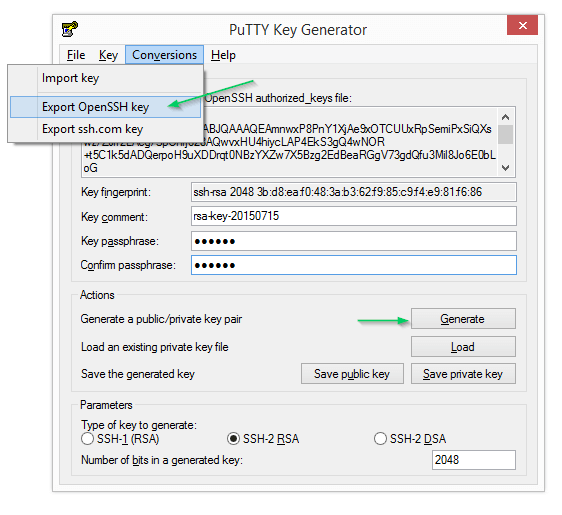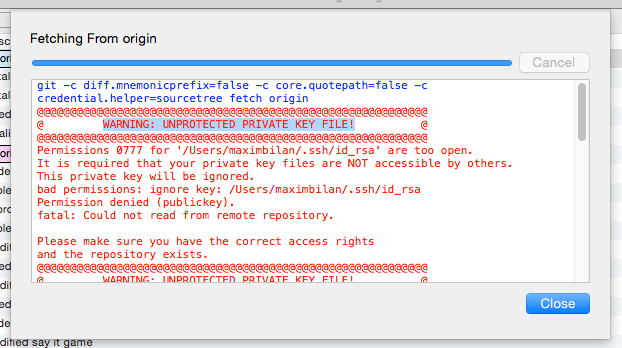Renci.SshNet.Common.SshException: Invalid private key file. At Renci.SshNet.PrivateKeyFile.Open (Stream privateKey, String passPhrase) Generated the keys using PuTTYgen, shown below is an sample format of private key file. It has both the public and the private keys. Ssh-agent is a program that can hold a user's private key, so that the private key passphrase only needs to be supplied once. A connection to the agent can also be forwarded when logging into a server, allowing SSH commands on the server to use the agent running on the user's desktop. Find out how to protect your server's sensitive data by learning how SSH keys work, creating an SSH key pair, and creating FTP users in SiteWorx. Hosted private cloud on enterprise hardware, powered by VMware & NetApp. Server Clusters. Multi-server configurations for maximum uptime & performance.

Traditionally OpenSSH has used the OpenSSL-compatible formats PKCS#1 (for RSA)and SEC1 (for EC) for Private keys.
- WARNING: UNPROTECTED PRIVATE KEY FILE! Permissions 0755 for '/home/etc.ssh/idrsa' are too open. It is recommended that your private key files are NOT accessible by others. This private key will be ignored. Bad permissions: ignore key: then the FILE PATH in.
- Padding for aligning private key to the blocksize; Note that the blocksize is 8 (for unencrypted keys, at least). The RFC 4253 SSH Public Key format, is used for both the embedded public key and embedded private key key, with the caveat that the private key has a header and footer that must be sliced: RSA private keys swap e and n for n and e.
This week I discovered that it now has its own format too,which is the default output format for some installations of ssh-keygen.
After peeking at the binary I found, much to my dismay - and very much unlikethe ssh public key format (RFC 4253) - that OpenSSH private key format isnot intuitively obvious, I headed to les googles.
I searched high and low (or at least past page 2, which is a distinguished markof true dedication), but found no useful information to assauge my curiosity(and habit).
In lieu of the docs I turned to the source. With a combination of theconcentrated efforts of my best code sluething and reverse engineering skills,I believe I have (here below) produced the most complete documentation theInternet has to offer on the subject.
Unprotected Private Key File Ssh Linux
So, without further ado..

OpenSSH Private Keys
Asio4all mac os x free download. On the outside it's PEM encoded. It looks like this:
But, unlike most PEMs, there's no DER inside.
Instead it's the 'proprietary' OpenSSH format, which looks like this:
As you can see (maybe) there's
- A format ID prefix
- Encryption headers
- An unused number for number of keys in the block
- An rfc4253-style ssh public key
- An private key somewhat modeled after the rfc4253 style
- A comment
- Padding for aligning private key to the blocksize
Note that the blocksize is 8 (for unencrypted keys, at least).
The RFC 4253 SSH Public Key format,is used for both the embedded public key and embedded private key key,with the caveat that the private key has a header and footer that must be sliced:
- RSA private keys swap
eandnfornande. - 8 bytes of unused checksum bytes as a header
- n bytes (between 0 and 7) of padding
- bytes > 0x00 and < 0x08 must be trimmed (from the right)
- the padding must be a (right-trimmed) substring of
0x01020304050607 - (that includes the empty substring)
- if the last byte isn't padding, it's part of the comment (0x21 to 0x7e)
Reference Material
The canonical source codeis only available via tarball (.tar.gz).
However, there's also a well-maintained fork (Portable OpenSSH)which has perfectly linkable source code and among them I foundthis to be the file of greatest interest:
Even more particularly, these were the most interesting functions:
sshkey_parse_private2sshkey_private_deserializesshkey_private_serialize_opt
I don't quite remember where, but another piece of information Idiscovered is that when the key isn't encrypted (cipher and kdfvalues are 'none' and 'none') the blocksize is 8 bytes and thevalue of CLFLAG_NONE is also 8:
By AJ ONeal
Did I make your day?
(you can learn about the bigger picture I'm working towards on my patreon page )
Please enable JavaScript to view the comments powered by Disqus.Log in with an SSH private key on Linux and macOS
Authored by: Brint Ohearn
This article demonstrates how to use a private key to log in to a Linux®server by using a private key with a Terminal session on macOS®. However,you can follow the same process to use a private key when using anyterminal software on Linux.
Note: For information about using Secure Shell (SSH) private keys on Microsoft®Windows® operating systems, seeLogging in with an SSH Private Key on Windowsand Generate RSA keys with SSH by using PuTTYgen.
Prerequisites
Private Key File Ssh
To complete this process, you need the following software applications:

Private Key Ssh File Location
- SSH client software that is installed on your Linux or macOS operating system by default.
- Your favorite text editor. This example uses the vim text editor.
- Your private key. For more information about generating a key on Linux or macOS, seeConnect to a server by using SSH on Linux or Mac OS X.
Unprotected Private Key File Ssh
Log in with a private key
Using a text editor, create a file in which to store your private key. This example usesthe file deployment_key.txt.
To edit the file in vim, type the following command:
Occasionally a reset of the Citrix Workspace is needed to fix issues with applications or desktops not appearing in Citrix Workspace. Procedure to reset on an Mac: Open the Workspace App In the upper left corner of your screen, next to the Apple symbol, click on Citrix Workspace and select Preferences: In the Preferences window, click on the Accounts tab then select the VDI. Mac os sierra citrix workspace. Users previously had printing issues while running the 7.15 LTSR VDA. We upgraded all users to 1912 and this resolved most of the users' printing issues. We have a user who is attempting to print from a Mac OS X host, but the printer always prints in duplex mode.
After the editor starts, press i to turn on insert mode.
Paste your private key, such as the one in the following image, into the file.Be sure to include the BEGIN and END lines.
To save your changes, press Esc.
Type :wq to write the file and return to the command line.
Run the following command to change the file permissions to 600 to secure the key. You can also set them to 400.This step is required:
Use the key to log in to the SSH client as shown in the following example, which loads the key in file deployment_key.txt, and logs in as user demo to IP 192.237.248.66:
When you are prompted to confirm the connection, type yes and then press Enter.
If your SSH key requires a password, enter it when prompted to complete the connection.
Share this information:
©2020 Rackspace US, Inc. Acrobat professional mac download.
Except where otherwise noted, content on this site is licensed under a Creative Commons Attribution-NonCommercial-NoDerivs 3.0 Unported License
